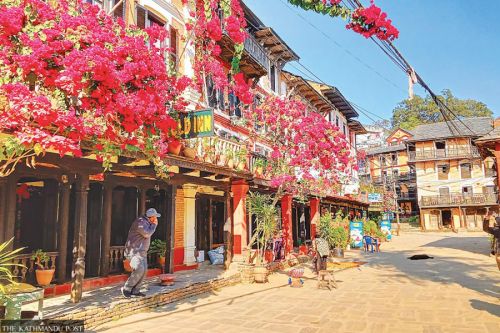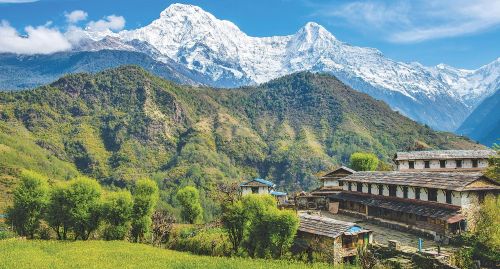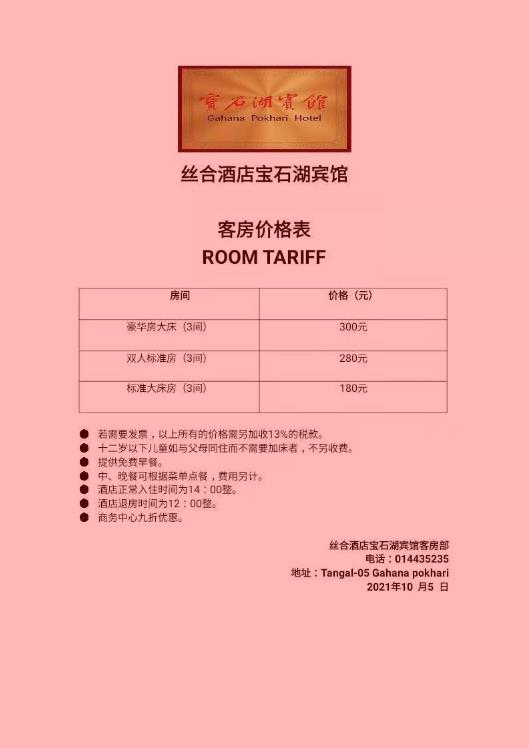
In a homestay, tourists live in people’s houses and share meals and experience local culture. Post File Photo
In 1980, the late Captain Rudra Man Gurung opened the first homestay in Nepal, Sirubari Homestay Retreat, launching a new kind of hospitality service in the country.
Located in a hill village in Syangja southwest of Pokhara, the homestay started by the former Indian Army officer put Sirubari on Nepal's tourism map, and it became a popular village tourism destination.
In a homestay, tourists live in people's houses and share their meals and experience local life and culture. Tourism in Sirubari flourished, creating economic opportunities for locals, particularly the marginalised community.
Homestays at Sirubari have won international accolades for their cultural richness. In 2001, Sirubari Village Tourism was awarded the Pacific Asia Travel Association Gold Award.
In 2011, the government announced Nepal Tourism Year which set off the homestay trend in the country in anticipation of a surge in tourist arrivals.
Homestay was conceived as an alternative arrangement for an expected hotel room shortage during the tourism campaign that was launched with the goal of bringing in 1 million tourists.
Homestays then become a permanent feature of Nepali tourism. Hundreds of homestays then started to pop up across the country. The government gave legal status to homestay by drafting a regulation. Homestays became a success.
Encouraged by the announcement of the Visit Nepal 2020 tourism campaign, small entrepreneurs started to build more homestays, targeting tourists who like greenery, a quiet and calm natural environment, and the culture in remote villages.
Living in a Nepali village as a homestay guest is perhaps one of the fastest and best ways to know the real Nepal. Daily cultural activities are a major attraction of the homestay scheme. Local governments also supported the move.
Currently, many individuals and community homestays are struggling to remain afloat as visitor numbers have dried up due to the Covid-19 pandemic.
The outlook in the post-Covid situation doesn’t look good either.
A community homestay at Galyang Municipality in Syangja registered around seven years ago receives only a few visitors these days.
Indra Thapa, chairman of the board of directors of the community homestay, said the Gandaki provincial government provided a Rs800,000 grant for a dozen homestays in Syangja.
“The financial assistance was provided to build a traditional round house, a common or look-alike house,” said Thapa. “But the budget was not sufficient.”
The provincial government had also provided a grant of Rs1.5 million to Bhalthum Community Homestay at Galyang-6. It too has not received visitors for a long time.
“Nowadays, many homestays do not meet the guidelines,” said Gopal Thapa, operator of Bhalthum Community Homestay.
Registered four years ago, Bhalthum Community Homestay is operated in five houses.
“Though we constructed the traditional round house, it is still registered under a person’s name,” said Gopal Thapa. “We are yet to register it under the homestay’s name.”
These are a few cases which show how the government is spending millions on the homestays but they are rarely productive.
The homestays were intended to generate sufficient income for locals and prevent them from migrating to other areas for jobs.

Tourism entrepreneurs say it will take a year for the country’s tourism to revive given the current low promotional activities. Shutterstock
In 2018-19, each community homestay was given a Rs1 million grant.
"Between fiscals 2018-19 and 2021-22, the provincial government invested Rs479.5 million in 324 homestays," said Bimal Gautam, information officer at the Ministry of Tourism of Gandaki province.
While many homestays are struggling to attract tourists, a few of them have closed completely, thanks to the Covid-19 pandemic. The pandemic has put the flourishing homestays in the doldrums.
Tourism entrepreneurs say it will take a year for the country’s tourism to revive given the current low promotional activities that could force many homestays to close.
Sigdi Homestay at Bareng Rural Municipality, Baglung, which has also received a Rs1 million grant, is now closed.
“We were forced to shut down as there were no visitors during the Covid period that lasted for months with restrictions and lockdowns,” said Hira Bahadur Pun, chairman of the board of directors of the community homestay in Baglung.
“As the village did not see guests coming, the local youths too began to search for alternatives. They are leaving the village for jobs in droves.”
The Covid pandemic was not the single biggest factor to affect the village tourism initiative.
Travel trade entrepreneurs say that many were opened for different purposes—mostly to misuse government grants.
Many homestays in the province have not followed the guidelines and have prioritised only building houses, they say.
The funds have to be utilised for constructing information centres, community or multipurpose buildings, and other infrastructure such as cultural museum, library, trekking trail, waste management, and electronic and communication facilities.
Though Gautam claimed that the budget had been used properly, insiders say there is no basis to prove that.
The leaders of various political parties accuse the then chief minister Prithvi Subba Gurung and tourism minister Bikas Lamsal of distributing the budget to their party cadres haphazardly.
“Obviously, there has been haphazard investment in homestays,” said Guru Prasad Bhattarai, mayor of Galyang Municipality. “The condition of homestays is in a mess. Important records are not available.”
The auditor general’s report for last year lists the grants given to homestays as arrears. The provincial government does not have records of the homestays registered in the province, the audit points out.
“Since the local units carry out the registration and renewal, we do not have any records,” said Gautam of the ministry.
The audit report states that only 85,152 visitors have stayed in 324 homestays in Gandaki province till the fiscal year 2019-20.
While the leaders say the intention of promoting homestays is reasonable, it lacks effective implementation.
“Though the objectives of the homestay programme are good, it could not be effective,” said Mohan Prasad Regmi, a Provincial Assembly member of the CPN-UML representing Syangja.
The audit report says that the homestays are not monitored either.
The procedure has a provision for providing Rs1.5 million as grant for upgradation of homestays run by individuals and Rs3.5 million for community homestays.
In the fiscal year 2020-21, the Tourism Ministry spent Rs132.5 million for infrastructure development in 117 homestays, according to the audit report.
Tourism entrepreneur Mohan Khanal said many operators lacked knowledge to run homestays.
“Most of the grants have been misused,” said Khanal. “The homestays failed to generate the desired outcome because the financial assistance was provided not on the basis of requirement, but on the basis of political connections.”
Udaya Subedi, chairman of Village Tourism Promotion Forum Nepal in Gandaki province, said that the grants were given without proper study.
“It looks like the elected representatives found a way to allocate the grants for their constituencies,” said Subedi. “The provincial government is not concerned about the outcome of the homestays.”
In Parbat, 48 homestays received Rs42.5 million in grants in the fiscal year 2018-19. But only a few homestays are still operating.
Some people in the bazaar area of Kushma, the headquarters of Parbat district, too received grants for operating homestays against the concept of promoting village tourism, insiders say.
Some homestays in Phalewash Municipality and Mahashila, Bihadi and Modi rural municipalities have misused the grants by investing the money in unproductive sectors, they say.
“A water tank was built at Jayagau Homestay in Modi Rural Municipality where it was not needed,” said a local, who wished not to be named. “The grant was misused. But if we protest, there will be repercussions.”
Panchkoshi Homestay at Kushma bought furniture worth Rs1 million with the grant in 2020. The furniture was left under the open sky as some of the homestay members refused to accept it citing irregularities by one of their partners.
The operators had alleged that products were of substandard quality.
“The homestay was asked to obtain replacements after protest from locals,” said Keshab Pudasaini, information officer at the division forest office, Parbat, which monitored the homestays. “The products were found to be substandard after an inspection.”
“The homestay in Baglung, whose board chairperson is Provincial Assembly member Dilmaya Roka, is being operated by violating the procedure,” said Mukunda Prasad Adhikari, chief of the division forest office.
“The grants should not have been allocated in a haphazard manner,” Adhikari said. “Many other homestays have also been given grants in violation of the procedure.”












